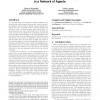Free Online Productivity Tools
i2Speak
i2Symbol
i2OCR
iTex2Img
iWeb2Print
iWeb2Shot
i2Type
iPdf2Split
iPdf2Merge
i2Bopomofo
i2Arabic
i2Style
i2Image
i2PDF
iLatex2Rtf
Sci2ools
ATAL
2007
Springer
2007
Springer
Multiagent reinforcement learning and self-organization in a network of agents
To cope with large scale, agents are usually organized in a network such that an agent interacts only with its immediate neighbors in the network. Reinforcement learning techniques have been commonly used to optimize agents local policies in such a network because they require little domain knowledge and can be fully distributed. However, all of the previous work assumed the underlying network was fixed throughout the learning process. This assumption was important because the underlying network defines the learning context of each agent. In particular, the set of actions and the state space for each agent is defined in terms of the agent’s neighbors. If agents dynamically change the underlying network structure (also called self-organizing) during learning, then one needs a mechanism for transferring what agents have learned so far before (in the old network structure) to their new learning context (in the new network structure). In this work we develop a novel self-organization...
| Added | 07 Jun 2010 |
| Updated | 07 Jun 2010 |
| Type | Conference |
| Year | 2007 |
| Where | ATAL |
| Authors | Sherief Abdallah, Victor R. Lesser |
Comments (0)

